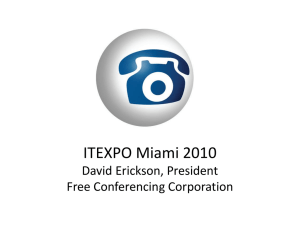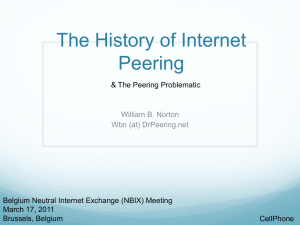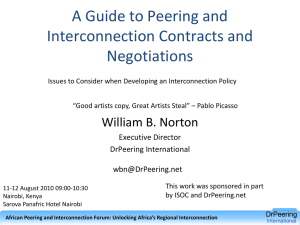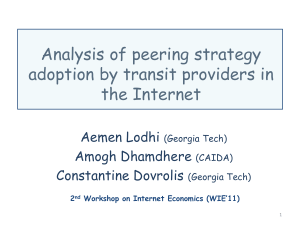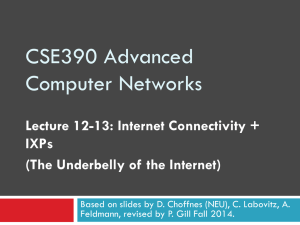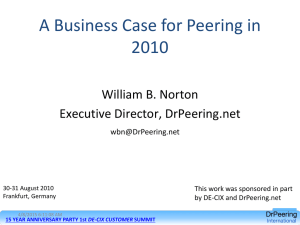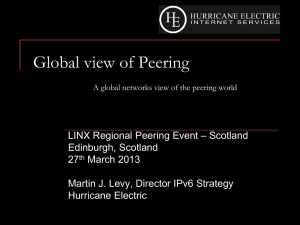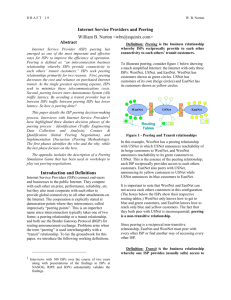Peering-Tutorial
advertisement
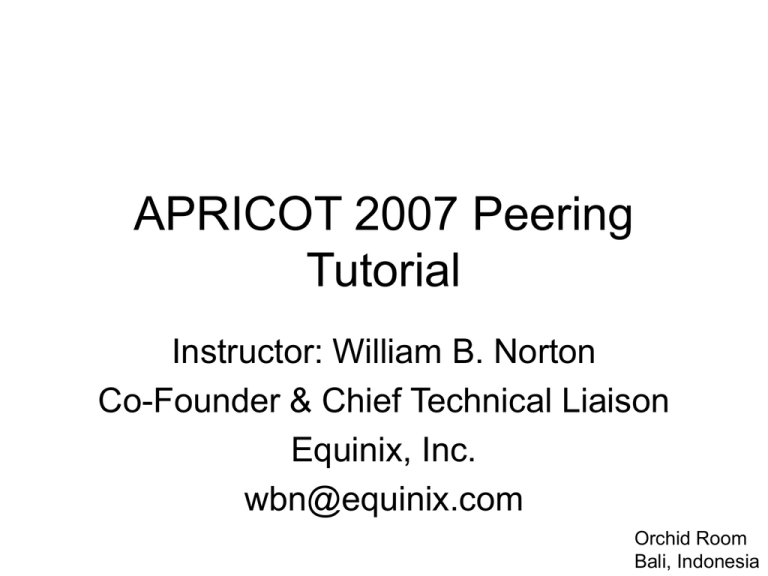
APRICOT 2007 Peering Tutorial Instructor: William B. Norton Co-Founder & Chief Technical Liaison Equinix, Inc. wbn@equinix.com Orchid Room Bali, Indonesia Agenda • 9:15 – 10:30 Introduction to Peering – Definitions, Applying the definitions – Motivations to peer or not • 10:30-11:00 Break • 11:00-12:30 Peering Simulation Game Internet Researcher • • • • • EQIX: Carrier Neutral Colocation 90% Externally Focuses Observe: documentation on HW&Protocols Lack of Operations documentation Research How does Peering work? White paper process.. Community Operations Research • Ground Truth w/dozens of experts • Write White Paper v0.1 • Walk community through WP for comments • Revise White Paper into new version • Present White Paper at conferences • Solicit comments over lunches and dinners White papers so far… Internet Operations White Papers “Interconnection Strategies for ISPs” “Internet Service Providers and Peering” “A Business Case for Peering” “The Art of Peering: The Peering Playbook” “The Peering Simulation Game” “Do ATM-based Internet Exchanges Make Sense Anymore?” 7) “Evolution of the U.S. Peering Ecosystem” 8) “The Asia Pacific Internet Peering Guidebook” 9) “The Folly of Peering Traffic Ratios?” 10) “Internet Video: The Next Wave of Disruption” 1) 2) 3) 4) 5) 6) Freely available. See Web site or send e-mail to wbn@equinix.com Start at the most basic definitions Definitions of Peering Take Notes The Internet is a Network of Networks. Def: Transit An ISP sells access to the Internet, so… …must itself get attached to someone who is already attached to the Internet. 1) Transit Provider sells metered access to the Global Internet Transit Provider A $ meter Transit Provider B 2) Peering is a business relationship whereby two companies RECIPRICALLY exchange Def: Peering access to each others customers. Why Peer? 1. Reduce Transit Costs 2. Lower Latency 3. More Control over Traffic Transit Provider A Peering Transit Provider B What is this Internet Peering Ecosystem anyway? Global Internet Peering Ecosystem JP Internet Region AU Internet Region US Internet Region Tier 1 ISPs Tier 2 ISPs Content Providers Characteristics of these Ecosystem Organisms? Ecosystem Member: Tier 1 ISP P Tier 1 ISP $ … $ T T P Def: A Tier 1 ISP is an ISP that has access to the ENTIRE Internet Region Routing Table Solely via Peering Relationships (Doesn’t buy transit from anyone to reach any destination in the Internet Region.) Motivation: Is NOT motivated to Peer in region to reduce transit fees, Is NOT motivated to peer with anybody else. Behavior: “Restrictive” Peering Policy $ $ T … T Ecosystem Member: Tier 2 ISP P Tier 2 ISP P Def: A Tier 2 ISP is an ISP that has to purchase Transit to access some part of the Internet Region. $ … $ T T Motivation: Is motivated to Peer in region to reduce transit fees. Behavior: “Open” Peering or “Selective” Peering Policy Active in Peering Forums $ $ T … T Content Providers Def: A Content Provider focuses on Content Provider content development and does not Sell access to the Internet. Motivation: SLAs w/well known ISP Behavior: “No Peering” Policy Generic Peering Ecosystem Tier 1 ISPs $ flow up T T T T T T T T T Tier 2 ISPs TTT Active Peering Groups Peering Forums IX Meetings Content Providers Quiz • Draw: Tier 1 ISP X – Piece of paper 1) Definition of Transit: ________________ 2) Definition of Peering: ________________ P Tier 1 ISP Y $ T T $ Tier 2 ISP B Tier 2 ISP A T $ Content Provider C 3) Definition of an “Open” Peering Policy: _____________________ 4) Definition of a “Selective” Peering Policy: _____________________ 5) Definition of a “Restrictive” Peering Policy: ____________________ Apply Defs: Peering Dynamics & Motivations Tier 1 ISP X $ P $ P? T Tier 1 ISP Y P? No, Tlike $. No, like $, Tier 2 ISP Tier 2 ISP T No, I already hear your routes for FREE! $ P? & I Like customer B Content Provider Synch Point: You have all the defs needed to predict behavior in the Peering Ecosystem. You should be able to answer the question at hand. Why Telstra Won’t Peer in Australia? Why Telstra Won’t Peer in Australia? That’s right. They don’t have to. Why Telstra Won’t Peer in Australia? They don’t have to. And, No different from other Tier 1’s in the world U.S. Evolution #1 EvolutionCable #1Companies Peer T1 ISPs Significant Evolution… T2 ISPs Content 1) Volume of traffic is huge 2) Cable Cos Open Peering 3) “Kazaa Effect” amplifies peering benefits U.S. Evolution #2 T1 ISPs Large Scale Content Players Peer Significant Evolution… T2T2ISPs ISPs Content Content 1) Volume of traffic is huge 2) Content is Open Peering 3) Improves End-User Experience 4) Leading Players are paving the way …need to move out of Bankrupt colo anyway… U.S. Evolution #3 Cable Cos Peer w/Large Scale Content Players T1 ISPs Significant Evolution… T2T2 ISPs ISPs T2 ISPs Content Content Content 1) Volume of traffic pulled away from T1s is huge 2) Reduces perceived need for T1s (for local delivery anyway) 3) T1s still needed for distance Content Literally right on the Cable Company Network The Process of Peering Peering Decision Tree: 3 Phases of Peering Agreed on Terminology Then the Interviews with Peering Coordinators and the 3 Phases of Peering: 1) Identification or Potential Peer – the who 2) Initial Contact and Qualification – the why 3) Implementation Discussions – the how What does Internet Transit Cost? Commit Commit Commit Commit to to to to 1 5 15 25 mbps mbps mbps mbps Transit Price Min/month $100 per mbps $100 $80 per mbps $400 $70 per mbps $1,050 $50 per mbps $1,250 Transit Cost Model $120 $/mbps $100 $80 $60 TransitPrice $40 $20 $0 1 5 9 13 17 21 25 29 33 37 41 45 Mbps Exchanged Motivations • Why Peer? Motivations for Peering Financial: Reduce load on expensive Transit service • Traffic src/dest • Measure vs Intuit • Usage-based Billing • Engineering: Lower latency Transit $$$ ISP A Seek transport Interconnection $ • 1st Stage of Peering: • Top 10 destination ISP list x Transit ISP ISP B Transit $$$ Top 10 list Sample Top 10 Destination List Internet Service Provider A AS Number Mbps Destination ISP 6172 24.35 HOME-NET-1 701 Contact [HOME-NOC-ARIN] 8.90 ALTERNET-AS [IE8-ARIN] 1668 8.14 AOL-PRIMEHOST [AOL-NOC-ARIN] 4766 7.08 APNIC-AS-BLOCK [SA90-ARIN] 3320 5.12 RIPE-ASNBLOCK4 [RIPE-NCC-ARIN] 4.24 BACOM [EQ-ARIN] 6327 3.90 SHAWFIBER [IAS-ARIN] 1 3.89 BBNPLANET [CS15-ARIN] 7018 3.66 ATT-INTERNET4 [JB3310-ARIN] 9318 3.13 APNIC-AS-3-BLOCK [SA90-ARIN] 5769 2.67 VIDEOTRON [NAV1-ARIN] 6830 2.30 HCSNET-ASNBLK [MD205-ARIN] 9277 2.22 APNIC-AS-3-BLOCK [SA90-ARIN] 2.08 TAMPA2-TWC-5 [JD6-ARIN] 2.05 SprintLink [SPRINT-NOC-ARIN] 577 10994 1239 Make W e Def: Peering I. Phase 1: Identification of Peer: Traffic Engineering Data Collection and Analysis • Reduce load on expensive Transit service Transit $$ • Traffic src/dest ISP A • Measure or Intuit Seek interconnection Transit ISP ISP B • ResultTop 10 list • 2nd Goal: Lower latency Transit $$ Part of Broad Business Relationship? Dominant Traffic Flow? Large new customer impact? Yes Phase 1: Identification of Potential Peer Traversing Expensive Transit Circuit? Yes Yes Will Peering have a positive affect on my network? Yes Proceed to Phase 2: Contact Peer Yes II. Phase 2: Contact & Qualification, Initial Peering Discussion A) Part of broader business transaction? a) E-mail person or peering@<ispdomain>.net b) Exchange point participant list c) Tech-c/admin-c from DNS/ASN registries d) Engineering Forums NANOG, IETF, RIPE, etc. e) Trade shows: speakers and booth staff f) Target ISP sales force g) Target ISP NOC II. Phase 2: Contact & Qualification, Initial Peering Discussion • Mutual NDA • BiLateral Peering Agreement (BLPA) • Traffic Value Data shared – One basis: PeeringCost<TransitSavings? • Requirements Exchange – (e.g. Must be at n Public Peering Points) • Either Party may walk away….. Finding the Right Contact Larger Business Transaction peering @ or personal contact Exchange Point Contact list Phase 2: Contact and Qualificatio n Initial Contact Sign NDA, see policies Share traffic data, BLPA Do both parties find motivation to continue peering discussion? No Close discussion Yes Proceed to Phase 3: Implementati on Discussion tech-c or admin-c in DNS/ ASN Registry Operations Forum Trade Shows Sales Force III. Phase 3: Implementation Discussions How to interconnect? Direct Circuit-based Interconnection Vs Exchange-Based Interconnection White Paper available: “Interconnection Strategies for ISPs” Email to: <wbn@equinix.com> Exchange-based vs. Direct Circuit Interconnection Cost Comparison of Interconnection Strategies $400,000 Direct Circuits Model Monthly Cost of Interconnection $350,000 $300,000 MUX Big Pipes Model $250,000 $200,000 Dark Fiber Model $150,000 $100,000 $50,000 64 61 58 55 52 49 46 43 40 37 34 31 28 25 22 19 16 13 10 7 4 1 $# of participants See http://www.nanog.org/mtg-9905/norton.html for slides Exchange Selection Criteria Criteria Includes: • • • • • • • • • Telecommunications Access Issues Deployment Issues (getting in & up) ISP Current Presences (there yet?) Operations Issues (restrictions?) Business Issues (neutrality/alignment) Cost Issues ($$) Credibility Issue (backing,attraction) Exchange Population (side effect) Existing Exchange vs. New Exchange? Facilities Allocation 100% 90% 80% 70% 60% 50% 40% 30% 20% 10% Facility fills Facility becomes widely known Critical mass is achieved Bulk selling of rack 10-packs Cross connect revenue grows rapidly First Carrier First ISP(s) First CP(s) “The Startup Hump” Large Facility Scaling Secondary Carrier(s) Multiple ISPs provide CP redundancy Time Exchange Environment Evaluation Exchange Environment Selection Criteria Telecom Access Issues Deployment Issues ISP Current Presences Operations Issues Business Issues Cost Issues Peering Implementation and Operation Credibility Issues Exchange Population Existing vs. Emerging IV. Summary • Findings from Interviews: Several phases lead to peering: 1) Identification of Potential Peers 2) Contact & Qualification 3) Implementation Discussions (Vary in rigor and policy) • 9 Selection Criteria for Exchanges (Vary in relative weighting of criteria) Peering Decision Tree Traffic Engineering Data Collection and Analysis Where is traffic destined? Where is it handed off in a peering or transit relationship? How will traffic on my backbone change as a result of regional peering? If beneficial to peer, where to peer? Yes Mostly e-mail/phone, conversations Sign mutual NDAs Peering Criteria met? If not, reestablish contact when criteria met. Discuss benefits to each of peering based on traffic data (MRTG Weekly MBps Avg) Does each side benefit equally? Peering Poker. Peering Negotiation Yes "Interconnection Strageties for ISPs" http://www.nanog.org/mtg-9905/norton.html demonstrate economic and technical dynamics of these two methods of interconnection Peering Methodology Discussion Yes Yes ExchangeBased Peering Direct-Circuit Peering Telecommunications Access Issues Deployment Issues Current Presence Exchange Population Who can sell me Circuits Easiest to peer where one and when? of us already has a Dark Fiber? presence How do I and how fast can Is there carrier diversity? I get equipment into the How fast can I get exchange? connectivity into the Can I get in? Side benefits of exchange exchange? Do I have to physically point? show up, flight, schedule, Who else can I peer with time costs, etc. or remote there? hands install? Are there transit sales How fast can contracts get possibilities? done? Operations Issues Cost Issues Is it easy to evolve my presence? More Racks? More bandwidth? Operations restrictions? "Must use" 1 carrier? "Must buy transit from a particular ISP?" Do I have to connect to a switch? Is the switch congested? Credibility Is exchange well backed? Will it be around next year? WIll it attract the "right" ISPs? When will critical mass be reached? What are the fees? Cost of alternative exchanges? What are the parameters surrounding fees? Do I have to connect to switch? When does Peering Make Sense Financially? Definition of Transport Def: Transport refers to the physical/data link layer media (e.g. circuits, gigE switching fabric, gigE over fiber cross connects). “I’m using Level 3 for transport into the Exchange Point” --or-“I’m using Telseon gigE for transport into the Exchange” 10M R 100M IX Switch R 10M 100M Peering versus Transit TransportIntoIX IXFees TotalPeeringCost $250 $200 $450 $500 $500 $1,000 Peering vs Transit $1,200 $/Mbps $1,000 $800 TransitPrice $600 10MPeer $400 100MPeer $200 $0 1 4 7 10 13 16 19 22 25 28 31 34 37 40 43 # Mbps Exchanged Generalization: ISP Peering Breakeven Analysis Graphs $/Mbps Exchanged Breakeven Point (ISPs Indifferent between Peering and Transit traffic exchange) Peering Prefer Peering Risk Cost of Transit Cost of Traffic Exchange in Peering Relationship Number of Mbps exchanged Why NOT to Peer… Already get Traffic for free (through existing peering relationships) • Personality Clashes • Traffic Inequities (“I don’t want to haul your traffic for free around the world!”) • Lack of Technical Expertise “We don’t believe you have the clue” • Transit Sales Preferred “Let me introduce you to our salesguys” • BGP is TOUGH Questions? Peering Simulation Game is next
